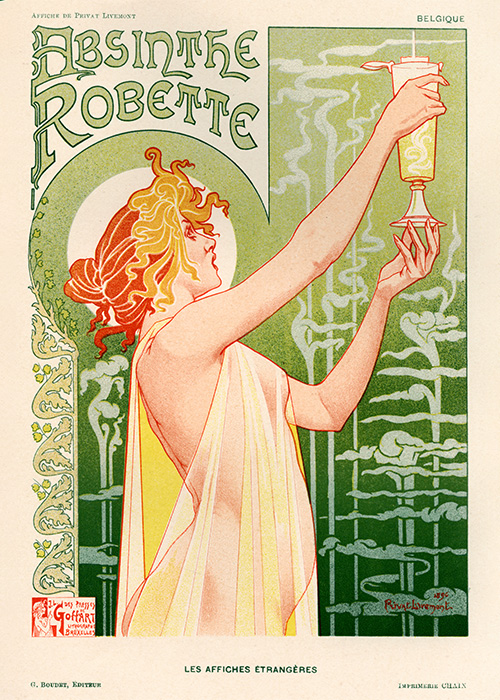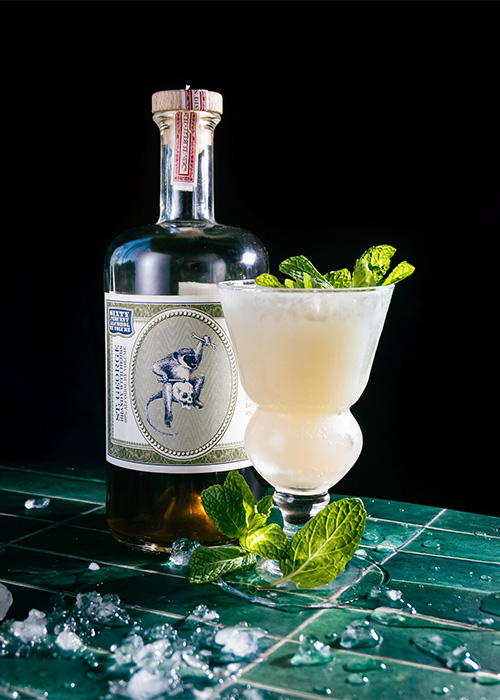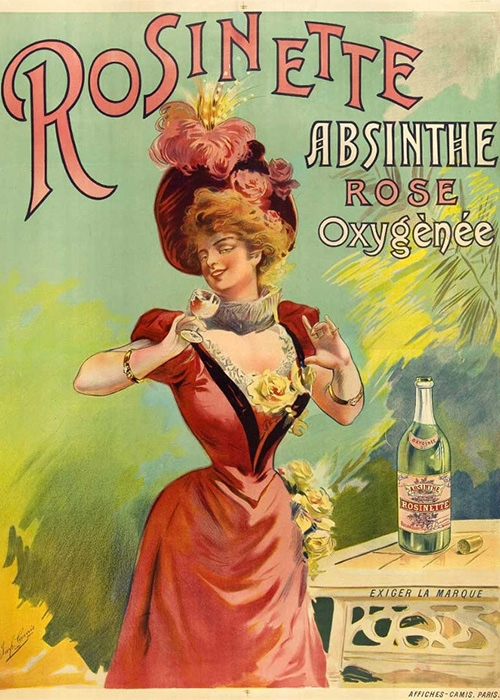A lot of drinks have interesting histories. And then there is absinthe.
The favorite boisson of 19th-century Paris, the great wormwood spirit is inexorably associated with its world-famous devotees. Artists like Edgar Degas, Édouard Manet, and Vincent van Gogh included it in their paintings, while Oscar Wilde, Arthur Rimbaud, and other Belle Époque literary luminaries hailed the drink known as la Fée Verte, or “the Green Fairy.” With French consumption swelling to 15 times the level of its 1875 volume by 1913, absinthe was so much a part of life in the country that the period before the First World War acquired a nickname among historians: les années vertes, or “the green years.” Then the drink mostly disappeared, due to a panic about its effects on health and a subsequent ban on its production and consumption that lasted for most of a century. That switch from ubiquitous to unavailable was so stark and long-lasting that many drinkers find it impossible to think of absinthe and not focus on the three or four decades of its greatest popularity.
But absinthe is hardly hogtied by its history. When I started researching my new book, “The Absinthe Forger: A True Story of Deception, Betrayal, and the World’s Most Dangerous Spirit,” I saw that the Green Fairy is changing in a number of ways. Although absinthe is celebrated for its past, the drink is developing new styles — from low-alcohol liqueurs to barrel-aged expressions and recipes with non-traditional ingredients — that will surprise fans who love it solely for its lore.
Don’t Miss A Drop
Get the latest in beer, wine, and cocktail culture sent straight to your inbox.
New Ingredients and Recipes
I first reported about the man who counterfeited historic “pre-ban” bottles of vintage absinthe in a 2021 VinePair column, though there was obviously much more to the story — and the secretive world of vintage absinthe collecting — than I could possibly fit into a single article. As I started putting together a book about the case, I saw just how profoundly modern absinthe had moved on from its history.
To start, plenty of modern distillers now put herbs into the drink that go far beyond the traditional “holy trinity” of grand wormwood, anise, and fennel, many of which would have been completely unknown in Belle Époque Paris.

In Germany, I visited Jan Hartmann, a distiller and scientist who served me a glass of his own delicious absinthe, Aixsinthe Blanche Noire, made with citrusy andaliman pepper from Sumatra. Other distillers around Europe told me about using plants that their grandparents or parents had never heard of, or lesser-known species of wormwood, or herbs that grow only in their regions.
While new herbs and spices can make for compelling new variations, any drink called absinthe should have aspects that connect to its past, explains Brian Robinson, owner of the Wormwood Society, an influential forum for absinthe lovers. To start, it should have the character of the three traditional herbs, in addition to any new ingredients. And to be considered a quality absinthe, the spirit should “louche,” or turn cloudy when water is added to it.
“Add some chilies in, sure, give it a little bit of spice,” he says. “If it’s louching and it still has predominant flavors of anise, fennel, and wormwood, then it’s all good.”
Those herbs can be a bit unorthodox, like the ones that California-based distiller Lance Winters puts into St. George Absinthe Verte.

“St. George is a good example of non-traditional,” he says. “It’s got basil, it’s got stinging nettles, it’s got things that you wouldn’t normally see in an absinthe, and it holds true enough that most purists would still say, ‘Yes, this is an absinthe, but it’s definitely a unique take.’”
There might be a limit to such open-mindedness — or a difference in where people see the line. When I interviewed Hartmann, he made absinthe sound like a jazz standard, a kind of widely recognizable classic that is open to individual reinterpretation. But according to the Czech distiller Martin Žufánek, the hardcore fans known as absintheurs had a different take when he worked with the Italian distiller Stefano Rossoni to produce an absinthe featuring herbs from southern Europe called La Grenouille.
“Amongst these 40 people who came to the wine tasting, I think they bought a couple of bottles of wine, but they bought 20 bottles of Crème d’Absinthe between them. It really tells you the potential of this type of product.”
“Absinthe fans are super into tradition,” he says. “When we distilled La Grenouille, they said, ‘Oh, Jesus Christ, this is much too floral, this is too Mediterranean. This is not absinthe.’”
Other aspects might get a pass. Robinson cites the example of Denver’s Leopold Bros., whose Absinthe Verte is made with imported Chilean pisco, a grape distillate. Žufánek himself has made a popular mead-base absinthe, using a distillate made from honey.
The Homeland of Absinthe
While absinthe now has both producers and fans around the world, nothing compares to its contemporary popularity in Switzerland’s Val-de-Travers, the small valley where the drink was invented in the late 18th century. Though Switzerland banned absinthe in 1910, the drink remained popular in its homeland near the French border, where moonshiners produced clandestine versions throughout its official prohibition.
Christophe Racine, an award-winning distiller who runs a well-stocked absinthe shop just steps from the museum Maison d’Absinthe, calls Swiss absinthe’s prohibition years its period of “research and development.” Herbs and spices that were previously unknown started to arrive when international trade expanded after World War II, and many clandestine Swiss distillers started working those products into their old family recipes.
“Historically speaking, when you look back at a lot of the major producers, they were aging in oak barrels, you know, incredibly large ones. So you wouldn’t get nearly as much influence of the oak on the absinthe.”
Other new developments followed absinthe’s re-legalization in 2005, including dark and oaky barrel-aged versions, the most famous of which, Patrick Grand’s remarkable Grand No. 5, played a key role in the absinthe forgeries I covered in my book.
At the nearby Val-de-Travers distillery La Clandestine, a 6-year-old barrel-aged expression called 1935 La Clandestine was inspired by distiller Claude-Alain Bugnon’s love of Cognac, co-owner Alan Moss explains.
“It is a miraculous blend, if you like,” he says. “You get all the good things of absinthe, and you get all the good things of something that’s been aged in new French oak for six years.”
Another new development from the Val-de-Travers, though generally unavailable outside of Europe: Crème d’Absinthe, a rich, eggnog-like liqueur. Absintheurs like to point out that, in addition to a beautiful louche and the inclusion of the herbal holy trinity, authentic absinthe is generally not sweetened. That’s not the case for the sugary Crème d’Absinthe, which also has much lower alcohol than traditional absinthe, around 15 percent (and which, with its pudding-like appearance, definitely doesn’t louche, either). It has the potential to attract drinkers who don’t like the traditional recipe, Moss notes, citing a group he witnessed at a recent wine tasting who had no interest in absinthe when they were offered the chance to sample the absinthe liqueur.
“Amongst these 40 people who came to the wine tasting, I think they bought a couple of bottles of wine, but they bought 20 bottles of Crème d’Absinthe between them,” he says. “It really tells you the potential of this type of product.”
The Future in the Past
While many of the new developments in absinthe seem cutting-edge, they might have historic precedent. Some modern producers have begun making red absinthe, turning the idea of the Green Fairy on its head. But a famous poster for Rosinette absinthe from around 1900 suggests that there could have been a red — or at least a rosé — version available in the drink’s Belle Époque heyday.
Barrel-aged versions might be trying to blend the black-licorice flavors of traditional absinthe with the contemporary interest in oak-aged spirits, but Robinson says that those expressions hint at absinthe’s origins, too.
“Historically speaking, when you look back at a lot of the major producers, they were aging in oak barrels, you know, incredibly large ones,” he says. “So you wouldn’t get nearly as much influence of the oak on the absinthe, but it’s kind of an extension of that, where it’s concentrating a little bit more and you’re getting more of those flavors.”
Even Crème d’Absinthe seems to echo the past. When I reach out to Nina Studer, a historian at the University of Geneva and the author of the new book “The Hour of Absinthe: A Cultural History of France’s Most Notorious Drink,” she quickly pulls up several historic recipes for Crème d’Absinthe from her files.
It’s difficult for a legendary drink like absinthe to find its footing today, she says, because even the false aspects of its origin story are frequently mined for marketing purposes.

“So many brands today play into this idea of it being a scandalous drink, of it being connected to secrets and danger,” she says. “They reuse imagery from the 19th century, consciously or not, in the images they use to advertise it, the names they choose, etc. So they consciously or unconsciously reuse the discourses of the 19th century on the drink, which is definitely limiting.”
Which seems like a pity. Absinthe has an enviable history, to be sure, filled with tales of romance and mystery, and I freely admit to having been seduced by many of those stories myself. But after researching the Green Fairy for most of the last three years, what now stands out to me is how great the drink actually tastes, including many of its newest versions, from new producers.
Drinks are a form of culture, after all, an aspect of our civilization that is alive, and thus subject to both change and growth. If we focus too much on the past of absinthe or any other historic spirit, we might miss out on the wonderful drinking experiences that lie ahead.